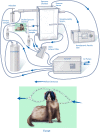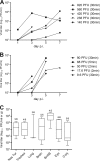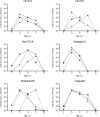Influenza virus infectivity and virulence following ocular-only aerosol inoculation of ferrets
- PMID: 24920819
- PMCID: PMC4136304
- DOI: 10.1128/JVI.01067-14
Influenza virus infectivity and virulence following ocular-only aerosol inoculation of ferrets
Abstract
Respiratory pathogens have traditionally been studied by examining the exposure and infection of respiratory tract tissues. However, these studies typically overlook the role of ocular surfaces, which represent both a potential site of virus replication and a portal of entry for the establishment of a respiratory infection. To model transocular virus entry in a mammalian species, we established a novel inoculation method that delivers an aerosol inoculum exclusively to the ferret ocular surface. Using influenza virus as a representative respiratory pathogen, we found that both human and avian viruses mounted productive respiratory infections in ferrets following ocular-only aerosol inoculation, and we demonstrated that H5N1 virus can result in a fatal infection at doses below 10 PFU or with exposure times as short as 2 min. Ferrets inoculated by the ocular aerosol route with an avian (H7N7, H7N9) or human (H1N1, H3N2v) virus were capable of transmitting the virus to naïve animals in direct-contact or respiratory-droplet models, respectively. Our results reveal that ocular-only exposure to virus-containing aerosols constitutes a valid exposure route for a potentially fatal respiratory infection, even for viruses that do not demonstrate an ocular tropism, underscoring the public health implications of ocular exposure in clinical or occupational settings.
Importance: In the absence of eye protection, the human ocular surface remains vulnerable to infection with aerosolized respiratory viruses. In this study, we present a way to inoculate laboratory mammals that excludes respiratory exposure, infecting ferrets only by ocular exposure to influenza virus-containing aerosols. This study demonstrates that the use of respiratory protection alone does not fully protect against influenza virus exposure, infection, and severe disease.
Copyright © 2014, American Society for Microbiology. All Rights Reserved.
Figures




References
MeSH terms
Substances
LinkOut - more resources
Full Text Sources
Other Literature Sources

